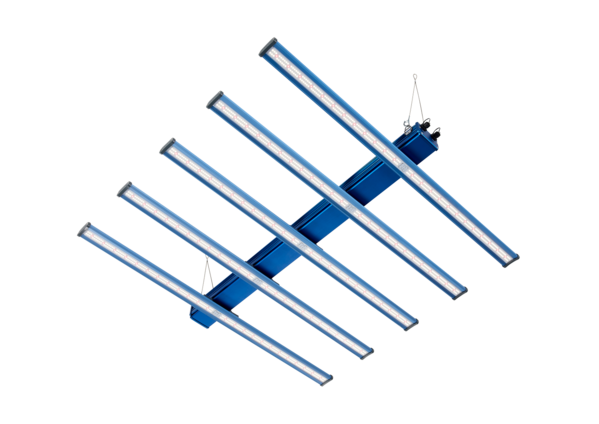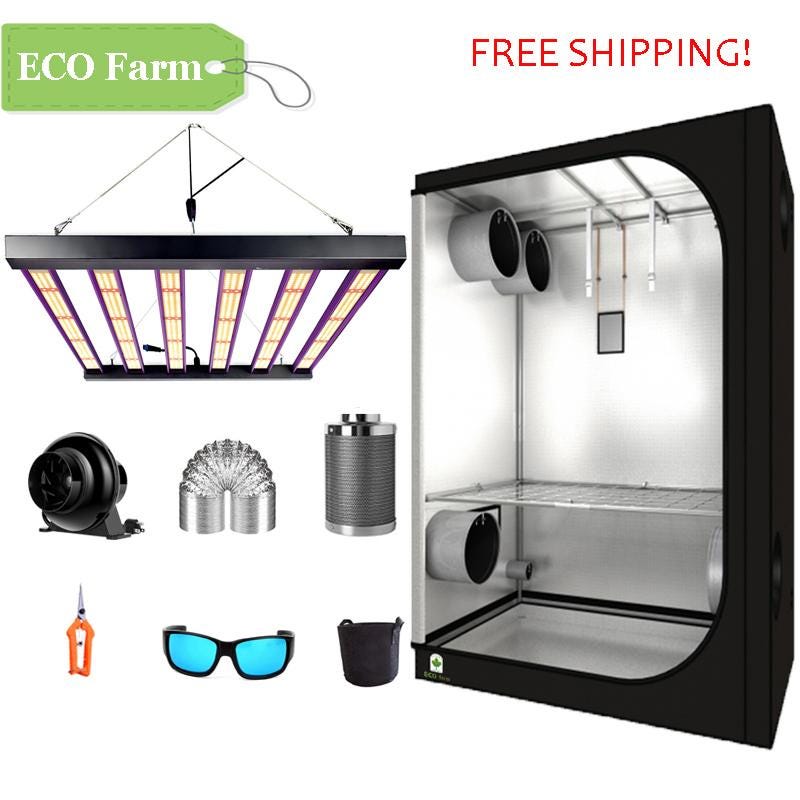未選択
-
[PR]
×
[PR]上記の広告は3ヶ月以上新規記事投稿のないブログに表示されています。新しい記事を書く事で広告が消えます。
-
ECO Farm ECO D700 700W Samsung LM281B Chip LED Grow Light VS Advance Spectrum 600W MAX LED Grow Light Bar
LED grow lights have become very popular as an effective way to provide light to plants to help them grow. These lamps provide specific light and heat to the plants, promoting their growth.
How far should the LED grow lights be from the plants?
In general, you should try to keep your LED grow lights about 12 to 30 inches above the plants. Of course, the wattage of the lights, the type of LED lights, and how the plants are grown will all affect this distance. If you’re using a 600-watt or 800-watt bright light, you should make sure the plant’s leaves are about 25 to 30 inches away from it.To determine the optimal distance for a plant to give it the best chance of healthy growth, you can use a “trick”.
Hand Test
Hold your hands under the LED Grow Lights at different heights — the heights your plants will be exposed to light. Hold your hand there for 30 seconds, if the heat is too much for you, you are too close. You want the LED grow lights to be close enough to provide heat to your plants without actually burning them.Doing more research on the type of plants you have is highly recommended.
ECO Farm ECO D700 700W Samsung LM281B Chip LED Grow Light
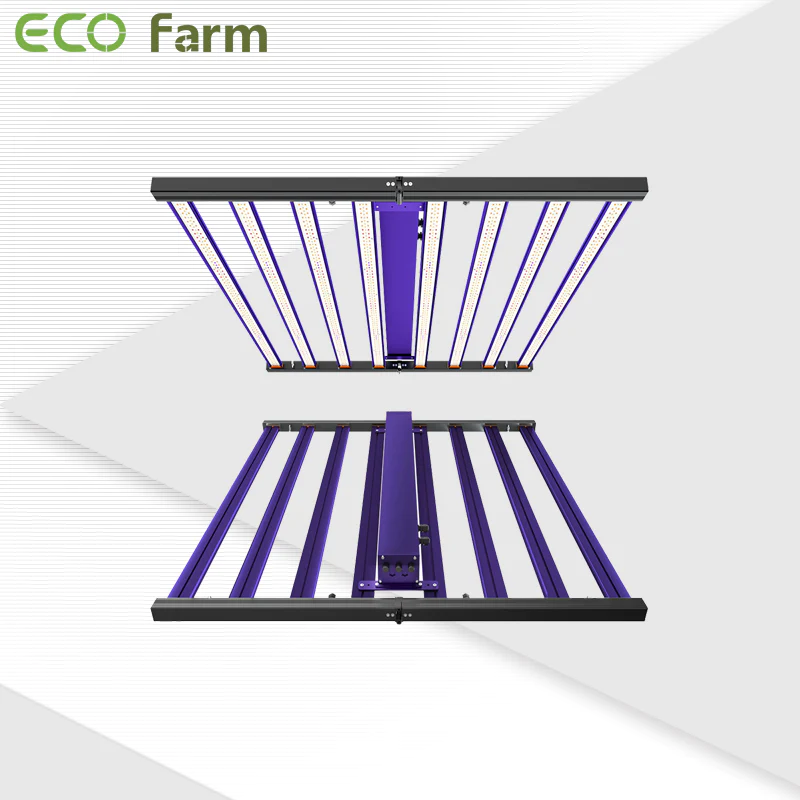
Features:
This ECO Farm LED grow light features the highest output white chips and Osram chips, with a high energy efficiency of 2.6 umol/J, PPF 1820 µmol/s, LED grow lights provide plants with powerful and high-quality light to maximize yield . The vegetable footprint is 5 x 5 feet and the flowering footprint is 4 x 4 feet. This grow light has an excellent full spectrum (3000K, 5000K, 660nm, 730nm IR, 395nm UV) and is ideal for all growth stages (germination, cloning or cuttings, mothering, vegetative and flowering applications) for higher yields . The dimming knob can adjust the light intensity at will. Designed with daisy chain function, up to 100 lights can be connected. Multi-light connections with uniform dimming are especially beneficial for large-scale indoor and commercial cultivation.
Advance Spectrum 600W MAX LED Grow Light Bar

Features:
The 600W grow light panel will support all your indoor and outdoor plantation requirements. The LED grow light is dimmable to adjust the lighting and heat intensity according to the requirement. With a single knob at the back of the grow light fixture, you can take control over the intensity of the panel and take control of the power output for seedlings, flowers, and veg. The LED has blue, red, orange, and red diodes that create optimal light conditions for achieving a healthy yield. The 600W LED grow light equals 1000W HID power. The LED is highly efficient and increases chlorophyll molecule absorption. With LED lights, you can save approximately 80 to 90% of energy consumption. The diodes heat up less, so you do not have to worry about your plants getting damaged. Also, with less energy consumption, you save on power. The LED is rated at 50,000 hours, which ensures a long lifespan.
Features to Look for
When purchasing the best grow light, we recommend looking for the following features in a prospective model.LED Lights
All modern grow lights feature design with LED technology. LED is effective and affordable to run. It’s the best way to give your plants the optimal spectrum they need for growth. LEDs have a longer service life than fluorescent, incandescent, or metal halide bulbs, and they use less electricity.LED Output and Power
When selecting your ideal indoor grow light, we recommend looking at the LEDs’ output in your prospective light. The average small grow light for seedlings needs between 45-Watts to 80-Watts of light output. That’s enough lumens to help your plants achieve optimal growth.LED Quality
The quality of the LEDs in your grow light makes an enormous difference in service life. The average high-quality T5 LED should provide you with at least 10,000-hours of service life before replacement.Light Spectrum
It’s critical that you look at the wavelength emitted by the device when purchasing your grow light. Plants require full-spectrum light for the best growing results. Look for models featuring a full PAR spectrum, offering both red and blue wavelengths. Some models will also feature white-light.Lighting Modes
Your LED grow light should feature different lighting modes. Look for models offering blue, red, and full-spectrum modes for your choice of growing conditions. The lighting modes affect your plants and how they grow.PAR refers to the balance of red, blue, and white light in your LEDs. Top models feature high PAR ratings, giving you the best performance out of your new grow light.
Timers
The best grow light for seedlings come with timers. You get the option of setting your light cycle to 3-hours, 6-hours, or 12-hours, depending on your plant’s needs.A timer is a handy feature in your light, allowing you to control the light cycle. However, if your model doesn’t come with a timer, you’ll have to purchase one separately or rely on manual operation.
Conclusion
LED grow lights are not just ordinary lights. The reason why they are so useful for indoor growing is that they provide the infrared and ultraviolet radiation that plants need.
Virtually every grower will confirm to you how important LED lighting is to plant growth and flowering.
So yes, LEDs are actually good for plants.
PR -
Spider Farmer SE5000 480W Full Spectrum LED Grow Light VS Maxibright Daylight 480w PRO LED Grow Light
Imagine an example where you’ve got everything set up for your indoor hydroponic farm, and then the question pops into your head; how many watts of LED grow lights should I provide for my plants? If you don’t know how to answer that question, this article will help you determine how much wattage to provide to your plants for optimal growth with LED grow lights. let’s start.
How many watts per plant LED grow lights?
Let’s use the square footage per plant to find out. The first thing you need to do is measure the size of your growing space or tent in square feet. After determining the area, choose an LED plant light with suitable light intensity according to this size. If you are still not sure, you should consult a lighting expert in a lighting store.Note that other factors may also determine your choice of LED grow lights. These factors will help to choose the right light intensity for plant growth.
What are the advantages of LED lights?
When you’re growing in a small, confined space like a grow tent, LEDs are really the only lighting option. Scroll down to read what makes LED lights better and more convenient than other options.Dimmability
Excellent dimmable LED lights to support your plants throughout their life cycle. The dimmable feature means you can adjust the light to a fraction of the power when you’re growing tiny seedlings, or when you need to light your plants for larger fruit for the last few weeks. Turn it to maximum. This is a big advantage of LED lights. Other lamps such as HPS, metal halide or fluorescent lamps have very limited dimming options.LEDs are cooler
Also, LED lights stay cooler compared to other lights, which is especially important for growing tents without much air circulation. A high powered HPS light will heat your tent in no time, while also drying out the air and increasing the need for humidifiers and ventilation, ultimately costing electricity and money.Power savers
For a similar light output, LED lights use only 60% of the energy needed compared to other options.Spider Farmer SE5000 480W Full Spectrum LED Grow Light
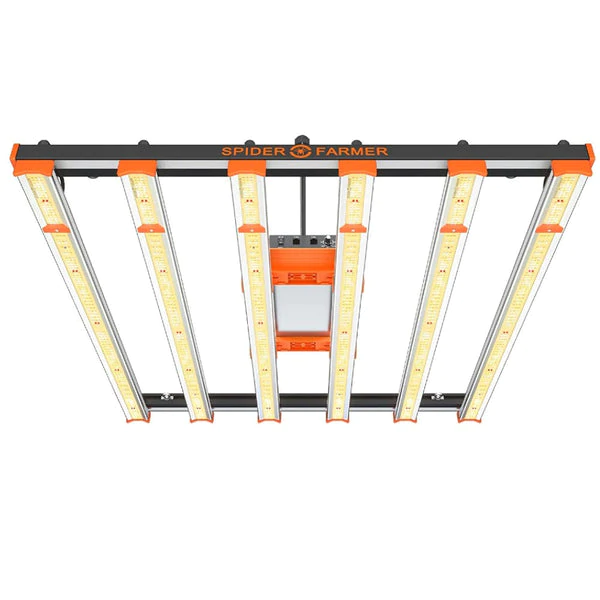
Features:
This Spider Farmer LED grow light features a uniquely designed 6 extended LED strips that provide more even canopy coverage, especially on the outer edges of the growing area. With 1680 SAMSUNG LM301B diodes, the SE5000 Led Grow Light consumes 480 watts at 1333 umol/s, achieving an impressive PPE of 2.75 umol/J, covering a high yield full-cycle growth of 4'x4'. The full spectrum (380–410nm, 660–665nm, 730nm, 3200–4200K, 4800–5000K) is ideal for vegetable flowering to suit every stage of the plant cycle. The dimmer knob is ideal for growers to adjust the light intensity for different growth stages. The daisy chain feature allows you to connect up to 30 spider farm grow lights — dimming multiple lights at the same time.
Maxibright Daylight 480w PRO LED Grow Light
Features:
The Maxibright grow light is suitable for growers looking for higher outputs and greater yields in a more compact and versatile unit. This fixture boldly bridges the gap between the higher and lower powered units in the range, meaning they’re adaptable to a wide range of applications such as propagation, multi-layer gardening and grow tents/rooms. The ability to dim the fixture from 25% up to 100% power, means you can use it from the early stages of growth right through to flowering. The DAYLIGHT 480W LED PRO boasts a full spectrum of light with a fixture efficiency of 2.7 μmol/J and a total output of 1296 μmol/s. This is all made possible by 5 bars of high-quality Osram and LUMLED LED chips, covering a 1.2m x 1.2m area perfectly, with outstandingly uniform light coverage.
Factors to Consider When Choosing the Best LED Grow Lights
The right power and the right coverage area
Power and coverage are two key factors to consider when choosing the best LED grow lights. The wattage of LED lights refers to the power consumed by LED plant lights, which is proportional to the light output. Generally, 400–600W of wattage is suitable for a 4×4 growing space. However, it’s important to note that higher wattage doesn’t always mean better coverage or higher light intensity. Coverage, on the other hand, refers to the area that a grow light can effectively illuminate. Grow tents require grow lights that can cover an entire area without leaving any gaps. Therefore, it is imperative to choose the best LED grow lights with the proper wattage and coverage to ensure that all plants receive sufficient light for optimal growth and yield.Full Spectrum LED Grow Lights Provide the Light Your Plants Need
Spectrum is another key factor to consider when choosing the best LED grow lights. Spectrum refers to the range of wavelengths of light emitted by grow lights, which is important for the photosynthesis process of plants. LED grow lights are available in a variety of spectrums, including full-spectrum lights for all stages of plant growth and broad-spectrum lights that offer different combinations of wavelengths. In addition, some LED grow lights have specific spectra, such as red and blue spectra, which are good for flowering and plant growth respectively. Therefore, it is imperative to choose LED grow lights with the right spectrum for the specific plants you plan to grow in your 4×4 grow space. By providing the correct light spectrum, you can ensure your houseplants receive optimal light for healthy growth and increased yields.Uniform PPFD for plant growth
PPFD (Photosynthetic Photon Flux Density) is another important factor to consider when choosing LED grow lights. PPFD measures the amount of light received by indoor plants, specifically the number of photons hitting a square meter per second. A higher PPFD means more photons are available for photosynthesis, which is essential for healthy plant growth. Optimal PPFD varies with the growth stage of the plant, with higher PPFDs required during flowering. Therefore, it is imperative to select LED grow lights with the proper PPFD based on the specific houseplants and growth stages that you plan to grow in your grow tent. By choosing LED grow lights with the right PPFD, you can ensure your houseplants get enough light for optimal growth and yield.High quality and excellent after-sales service
Durability and warranty are also key factors to consider when choosing LED grow lights. Durable grow lights will last longer and provide consistent performance, ensuring your grow light investment is worth it. Plus, the warranty ensures that you can get a repair or replacement if the grow lights break down or fail during the warranty period. Therefore, it is very important to choose a reputable LED grow light with a quality guarantee of at least one year and good after-sales service. By choosing a durable grow light with a warranty, you can have peace of mind and confidence in the longevity and performance of your grow light.Cost-effective LED grow lights
Price and budget are also important factors to consider when choosing LED grow lights. The price of LED grow lights varies, and the cost depends on many factors such as wattage, coverage and spectrum. When choosing grow lights, it’s important to set a budget and stick to it to avoid overspending. However, it is important to note that these cheap grow lights may not provide optimal performance and quality, which can affect the growth and yield of your plants. Therefore, it is recommended to choose cost-effective LED plant growth lights. By choosing LED grow lights within your budget, you can be sure that you are getting a quality grow light with the best performance without breaking the bank.Conclusion
A rule of thumb is 32 watts per square foot of planting area. But remember to take other influencing factors into consideration when choosing grow lights. Familiarize yourself with the information presented here and you’ll be well on your way to mastering grow lights.
With that being said, we hope you can figure out how many watts each type of plant LED grow light needs for optimal growth.
Happy gardening!
-
Best 5x5 Grow Tent 2023: TopoGro w VS Gorilla
Start growing plants indoors with the best grow tents that can create the ideal environment for your indoor garden. When space and persistence are important factors, a quality grow tent is essential to successful cultivation. The sides of the tent allow for proper ventilation, and the tent provides easy access to plants.
How big a grow tent do you need?
“The size of your grow tent will ultimately depend on how much you want to grow,” says Sears. “If you’re only going to grow one or two potted plants, you can use a small 2' by 2' or 2' by 4' tent. Large grow tents can be as large as 10' by 10' and can house dozens of plants. “When you’re shopping for the best grow tent, you also need to consider how much space you need to use. If you only have a few plants in your home, we recommend starting with a small grow tent to save space and money. If you’re an experienced gardener with lots of greenery, you might benefit from a larger grow tent — but be prepared to sacrifice a lot of acreage.
TopoGrow 60X60X80 LED Grow Tent Kits
Features:
The TopoGrow grow tent kit has a 600W LED Grow Light Actual power is 220W, High PPFD,the PPFD is 1316 μmol/m2/sec at the height of 18 inches, AC85~265V, it could be connected with HPS (not suggest), Patented unique design of reflector cups for higher light-gathering effect. High PAR value and Lux value than normal led grow light, reducing light and Par value loss. Grow Tent uses heavy duty 600D lightproof oxford cloth and white paint coated metal rods and Large heavy duty Zippers. 4" Ventilation Kit ensures effective Odor Control: Eliminate some of the most undesirable odors, pungent smell, and particulates from indoor grow tent, hydroponics grow room
Gorilla 5ft x 5ft x 6ft11inch w/ Ext 7ft11inch Grow Tents
Features:
Gorilla Grow Tents are professionally designed grow tents that are ideal for experts and perfect for beginners. The expert configuration positions ducting ports where they should be. Large EZ View windows offer easy grow snapshots without compromising your environment. The doorways offer 360 degree convenient access. The larger layouts provide frustration free maneuvering. Thick material and large 10″ double cinching ducting ports make maintaining an ideal growing space a snap. With a huge thread density of 1680D (compared to 200D — 600D) Gorilla Grow Tents are up to 3–9x denser than ANY grow tent ever made. Features a solid metal interlocking frame that is up to 2–5x stronger than any competitor’s grow tent frame. Gorilla Grow Tent frames are so strong they can hold up to 300 lbs.
What to pay attention to when choosing a grow tent
What Features Make Up the Best Grow Tent? Here’s what to look out for:Expand tent size. The ideal size depends on your harvesting ambitions, lamp type and available space. A larger tent can get you upscale, but a big tent wastes resources. Typically, how many plants can a tent hold:
Fabric strength and density. Dense material increases durability and prevents light leakage. Don’t settle for less than 600D (denier, a measure of density) on an entry-level tent. Professional growers may choose the 1500–2000D.
High quality zippers and stitching. Zippers and stitching hold the canvas in place, so they must be durable. Look for metal or heavy-duty plastic and double-stitched seams.
Frame strength. The internal frame holds the canvas and equipment in place, so look for metal poles and sturdy corner joints. Check that it can carry gear before bringing it into the plant.
Vent. Grow tent ventilation removes stale air and prevents plant health problems. There should be at least two 6–8" intake and exhaust ports, but four is better.
View window. Keeping the tent cover open can disrupt the microclimate and cause light leaks. Windows allow you to inspect plants without disturbing the garden.
Accessory pocket. Growing plants requires tools for feeding, watering, and mowing. The pockets on the side of the tent are very convenient to keep everything in place.
Removable tray or overflow tray. Lingering runoff can damage power tools, increase humidity, and allow pathogens to multiply. Trays allow you to easily remove excess water, so don’t skip them.
Avoid PVC and PU canvas. They release toxic fumes that can harm you and your plants. Also, avoid cheap tents (under $100), as their affordability is often due to low-quality materials that can crack and leak light.Conclusion
What should the “best grow tent” offer?
The best grow tents not only have sturdy stands and thick materials, but they also meet quality standards. The best grow tents are designed to control light and temperature to create the optimal growing environment for your beloved plants.
-
The Best 4x4 Grow Tents Review in 2023
Grow tents can solve many common problems for gardeners, including lack of space or suboptimal plant hardiness zones. Whether used indoors or out, they are the foundation of your perfect growing environment — all you have to do is build it with the right lights, vents and more.
The main benefits of choosing a grow tent
A grow tent is a structure specially designed for growing plants. It is opaque on the outside and shiny on the inside, like a small closed growing room.People use tents to produce sticky shoots without permanently modifying parts of the house. Aside from convenience, a well-functioning grow tent setup:
Minimize space requirements. The grow tent contains your plants, lights and supplies. You need less space to create a full garden.
Contains a plant odor. The tent has efficient intake and exhaust fans, which easily scrub the aromatic molecules in the air. All odors remain within the structure.
Promotes plant health. The good ventilation and sealing of the planting tent make the internal climate easy to manage. Pests and pathogens are inaccessible, greatly reducing the likelihood of crop disease.
Optimize exposure. The tent is lined with reflective material to catch the last rays of light from the lamps. Light ping pong balls fall from the wall and spread evenly across the canopy.
Reduce power consumption. Tents limit the size of your grow space and optimize the functionality of each piece of equipment. They waste no electricity and cost less than an open air grow room.
Maximize harvest potential. The above benefits ultimately result in higher returns per square foot for your space. Plants stay healthy, bathed in sunlight, and produce mounds of clumps.
Want to reap these benefits? You need the best grow tent for plants.ECO Farm 4'x4' Essential Grow Tent Kit with ECO Farm DBL5000 480W LED Grow Light
Features:
The ECO Farm grow tent kit is simple to set up, making it easier to start planting. The ECO Farm Essential planting tent kit is removable, so you can take it with you. The structure of the tent is stable, the outer layer is 600D Oxford cloth, the inner layer is 96% highly reflective waterproof diamond polyester film, and the external zipper design ensures safe use and easy installation. It also has multiple vents to accommodate fans and filters. The ventilation kit is a complete combination to eliminate odors. The grow tent kit adopts the user-friendly “full-spectrum” design of Grow Light. The full spectrum (3000K, 5000k, 660nmnm, 30nm) is very suitable for vegetable flowering to adapt to each stage of the plant cycle. You can easily For planting plants in any growth cycle, the uniquely designed 6-LED light bar provides more uniform canopy coverage, especially on the outer edge of the planting area.
Active Grow Walden White Grow Tent 4' x 4'
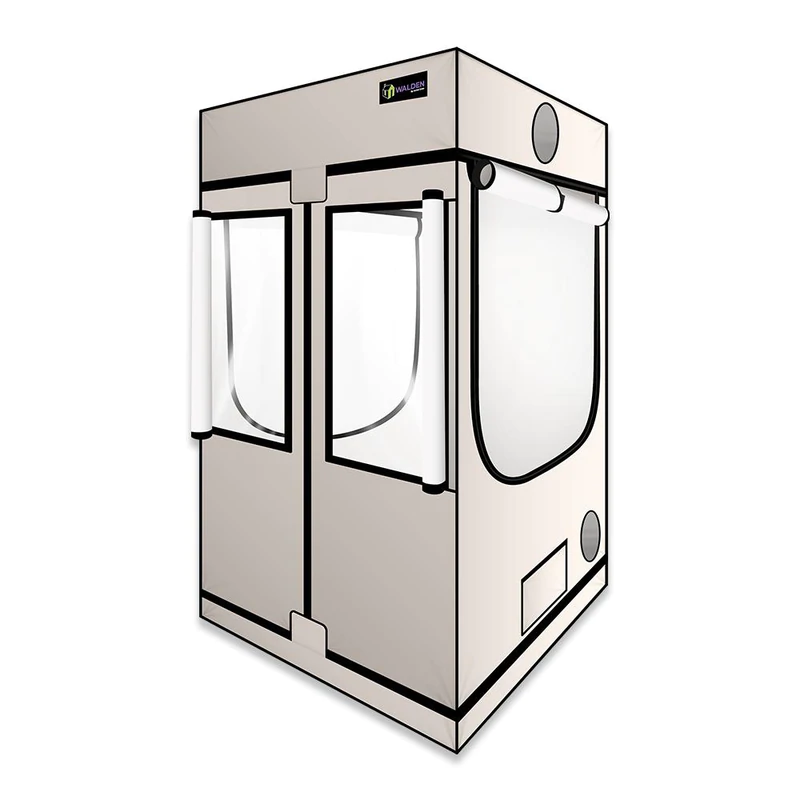
Features:
Designed with nature in mind, the Active Grow Tent provides professional home growers with a tent that meets their needs in form and function. All Walden Grow tents are constructed with industrial strength zippers and 100% EcoWhite PEVA material. This non-toxic material creates a clean look for the grow space and emits no harmful chemical fumes, allowing these tents to be safely placed in public settings without any health risk to friends or family. The three-layer design consists of a 600D canvas exterior, vinyl blackout center, and white vinyl interior that is 10% more reflective than even the most reflective Mylar tents. Double wide front doors give growers easy access to plants, and large roller shutter side doors allow growers to reach even the most difficult to reach areas.
VIVOSUN G448 Upgraded 4x4 Mylar Grow Tent with 19mm Poles
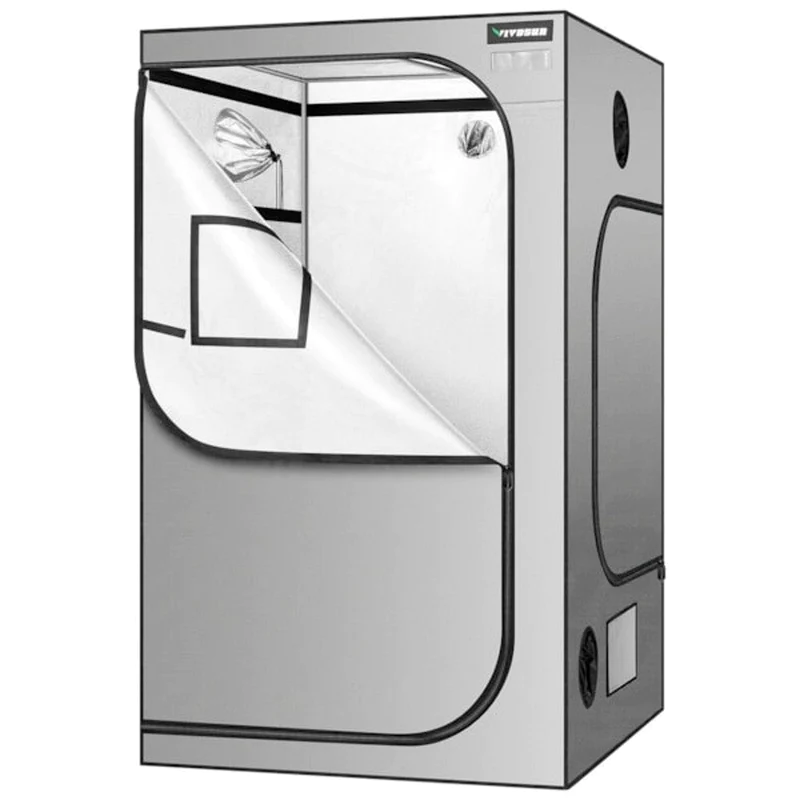
Features:
This VIVOSUN grow tent features high-density 600D oxford fabric to prevent light leaks and keep your grow area well insulated; interior walls, ceilings and floors are lined with 100% diamond reflective polyester film for multi-dimensional lighting. Grow tents are equipped with vents to install ducted fans and carbon filters for optimal airflow and ventilation; dual-cinched duct ports seal the tent effectively while allowing air to flow freely in and out of the grow room.
5 Reasons You Should Use a Grow Tent
Grow tents are great for gardeners of all kinds, but if you’re still hesitating about getting one, here are five reasons we think you should consider:1. Total control
Many environmental factors contribute to healthy plant growth, including controlling temperature, humidity, light duration and intensity, ensuring proper air circulation, and more.As you gain more gardening experience, you’ll feel more comfortable not only controlling these factors, but manipulating them to produce larger, healthier plants.
But many people new to indoor gardening have trouble even maintaining stable environmental conditions.
The fact that grow tents are designed to make creating and managing these environmental conditions simple is certainly the best reason to use a tent.
2. Avoid pests and infestation
The enclosed design of the grow tent keeps out unwanted pests like aphids and spider mites.Anyone who has grown plants outdoors can attest to how easy it is for pests to infest your plants, and how challenging it is to eradicate them.
So as long as your plants and equipment are clean, they should be protected from pests and diseases.
3. Energy saving
The mylar interior expands the reflective surface area of the grow tent, increasing the efficiency of light.Thanks to this design, your plants will get the best possible light so that no precious light is wasted. In turn, this makes grow tents very energy efficient.
4. Versatile and adaptable
A grow tent is an excellent way to utilize a space without completely changing it. You can easily grow plants in a grow tent in your garage or spare bedroom.Once you’ve completed your growth cycle, you’ll have no problem fully deconstructing your growth space.
The tent is also extremely adaptable as it transitions from the vegetative phase to the flowering phase. They also make the transition from soil to hydroponics extremely easy.
5. Plant whatever you like
No matter the weather, light or humidity conditions outside, you can easily grow indoors with a grow tent.A grow tent actually makes it easier to grow any kind of herbs, vegetables, fruits or flowers you want because it can be customized.
Using a tent can help you create a mini artificial environment with the exact conditions you need, in the comfort of your own home.
So whether you live in the Northeast for the winter, or you’re in the South and want to grow plants that aren’t suitable for USDA zones, you can use a grow tent to grow whatever you like.
Conclusion
The best grow tent is a relatively low investment that can go a long way in upping your gardening game. Home growers love them for their increased yields and versatile properties.
As a bonus, the selection is more comprehensive than ever. From microstructures to multi-room mansions, from basic to decorative, modern tents have something for everyone.
All that’s left is to find what works for you, and we make sure you won’t settle for the best.
The aforementioned brands offer exceptional durability, quality, and off-the-shelf convenience. Our listings contain items to suit everyone’s budget, needs and aspirations, so you can choose your tent with confidence.
-
Optic Slim 720S Dimmable LED Grow Light VS Spectrum King Phoenix 680W LED Grow Light
You must be familiar with LED lights because these lights are used for almost everything these days. Whether you want indoor lights for your home, smart lights, or decorative lights for your outdoors, you’ll find plenty of options for using LED lights.
However, there is a more niche category of LED lights that are usually only familiar to those with a passion for indoor growing and botany.
What is spectrum and how does it relate to my garden?
The electromagnetic spectrum is the broad frequency range of electromagnetic radiation. In layman’s terms, we are surrounded by invisible waves of various sizes and speeds. These waves are very small and are measured in nanometers (nm). A nanometer is one-billionth of a meter. Some of the better known parts of this spectrum include X-rays, microwaves, and radio waves. A part of the spectrum that you may not be aware of is the visible spectrum.This part of the electromagnetic spectrum is the only part visible to the naked eye. These waves range from approximately 400 nm to 700 nm. The classic acronym “ROYGBIV” used to remember the colors of the rainbow can also be used to remember the order of the visible spectrum. Red is at the upper end of the spectrum (700 nm), violet is at the lower end of the spectrum (400 nm), and in the middle is yellow/green light (~550nm).
You can use this information to better understand which lights produce these wave frequencies in order to provide your plants with the correct color of light.
Optic Slim 720S Dimmable LED Grow Light

Features:
Optic LED grow light is the Most Powerful Triple Dimmer LED Grow Light Ever Created. Offering all the stunning proven technology from the highly refined Slim 650S, the Slim 720S features a start-up Meanwell drive system that emits up to 720 watts of light through 3,096 of the world’s most efficient LEDs. The Slim 720S is designed for growers in a 5x5 area or just want to save power in a 4'x4' area. The Slim720S is designed to give you more performance than any other LED grow light company on the market today. It features the new Samsung LH351H deep red LED rated at 3.75 umols/J and the Samsung white LM301H LED above 3.0 umols/J. Royal blue, infrared and ultraviolet round out the spectrum.
Spectrum King Phoenix 680W LED Grow Light
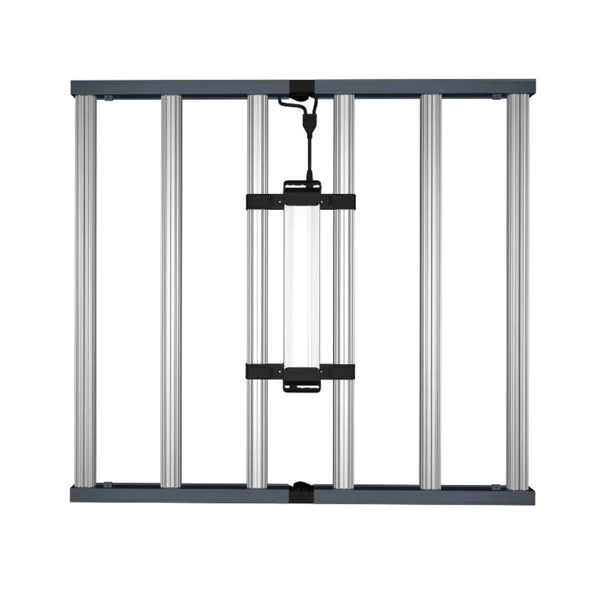
Features:
The Spectrum King LED grow light is the new LED standard for a 1:1 1000W DE HPS replacement that consumes 36% less power while offering the highest reliability in the industry. SK Cryo-Therm cooling technology enables an ultra-thin profile that maximizes airflow and minimizes microclimates. This grow light is optimized for single or multi-level planting close to the canopy. Many growers are switching from heat-generating HPS lights to ultra-high performance LED strip lights. SonoFarm LED grow lights utilize the latest technologies on the market — from intensive research for optimum performance, to customising the spectrum for the highest possible yield.
Why Use LED Grow Lights for indoor plants?
Flowers thrive under full-spectrum LED grow lights. Compared to traditional lighting systems like HID and HPS lights, LEDs are the best choice for indoor gardening. Here are some advantages:Broad Spectrum — LEDs offer greater flexibility and a wider spectrum combination than spectrally limited HPS and HID lamps. They are also capable of enhancing specific wavelengths, such as UV and IR, to suit specific needs in your garden.
Lower Heat Output — LED grow lights run cooler than other types of grow lights because they don’t burn anything to produce light. Not only does this reduce electricity costs, but it also protects your grow room from overheating.
Increased Efficiency — LED grow lights are more efficient than HPS grow lights; they consume 60% less energy for the same amount of light. For example, the 680w lamp we list provides more intense light than a 1000w traditional lighting system.
Longer Life — For lights that last a long time, use LEDs. Due to their non-chemical structure and low operating temperature, they can last over 50,000 hours.
Conclusion
LED grow lights have become more and more popular over the past few years. Using LEDs instead of other types of LEDs costs less and consumes less electricity than fluorescent and HID lighting. They also don’t generate much heat that can damage seedlings or affect plant growth.
LEDs are cheaper in terms of electricity usage and the bulbs last longer. While purchasing LED fixtures can be more expensive, most buyers say they will keep costs down in the long run. Low energy consumption and high efficiency.

